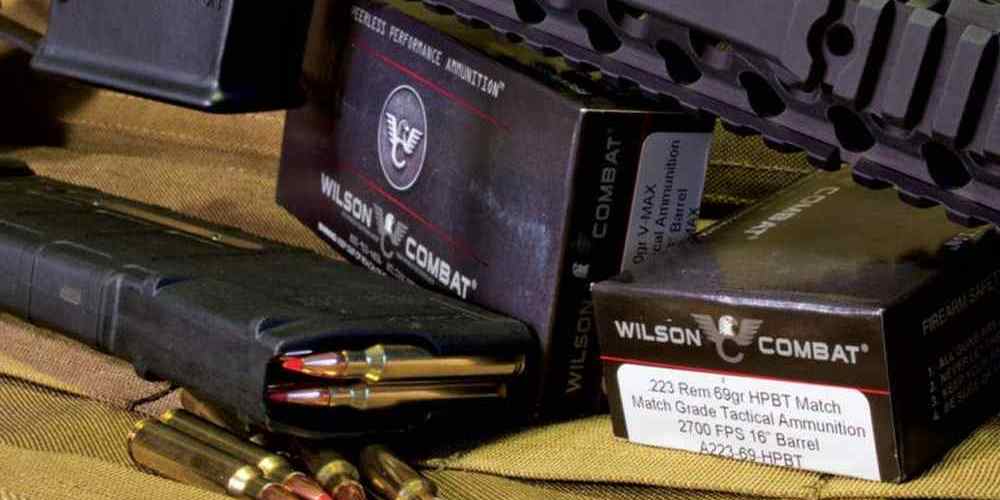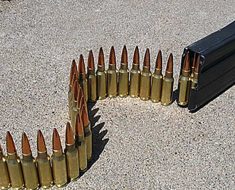“Know your calibers: .223 in a 5.56 chamber – proceed with caution.”
Potential Risks of Firing .223 in a 5.56 Chamber
If you’re a gun enthusiast or a seasoned shooter, you may have come across the debate surrounding the compatibility of .223 and 5.56 ammunition. While these two calibers are often used interchangeably, there are some key differences that shooters should be aware of to ensure their safety and the longevity of their firearms.
One of the most common questions that arises in this debate is whether it is safe to shoot .223 ammunition in a firearm chambered for 5.56. The short answer is that it is generally safe to shoot .223 in a 5.56 chamber, but there are some potential risks that shooters should be aware of.
The main difference between .223 and 5.56 ammunition lies in the pressure levels generated when the round is fired. 5.56 ammunition is loaded to higher pressure levels than .223 ammunition, which can result in increased wear and tear on a firearm not designed to handle the higher pressures.
When shooting .223 ammunition in a 5.56 chamber, shooters may experience increased recoil and muzzle blast due to the higher pressure levels of the 5.56 round. While this may not pose a significant risk to the shooter, it can impact the overall shooting experience and accuracy of the firearm.
Another potential risk of firing .223 in a 5.56 chamber is the possibility of overpressure, which can lead to malfunctions or even catastrophic failure of the firearm. Overpressure occurs when the pressure generated by the round exceeds the limits of the firearm’s design, which can result in damage to the gun and potential injury to the shooter.
To mitigate the risks associated with shooting .223 in a 5.56 chamber, shooters should be mindful of the ammunition they are using and ensure that it is compatible with their firearm. It is always best to consult the manufacturer’s guidelines and recommendations for ammunition compatibility to ensure safe and reliable performance.
In addition to using the correct ammunition, shooters should also regularly inspect their firearms for signs of wear and tear, especially if they frequently shoot .223 in a 5.56 chamber. Regular maintenance and cleaning can help prevent potential issues and ensure the longevity of the firearm.
While shooting .223 in a 5.56 chamber may pose some risks, with proper care and attention, shooters can safely enjoy their firearms without compromising safety or performance. By understanding the differences between .223 and 5.56 ammunition and taking the necessary precautions, shooters can continue to enjoy their hobby with peace of mind.

In conclusion, while it is generally safe to shoot .223 in a 5.56 chamber, shooters should be aware of the potential risks associated with doing so. By using the correct ammunition, regularly maintaining their firearms, and being mindful of overpressure, shooters can enjoy their firearms safely and responsibly. Remember, safety always comes first when it comes to shooting sports.
Understanding the Key Differences Between .223 and 5.56 Ammo
If you’re a gun enthusiast or someone who is new to the world of firearms, you may have come across the terms .223 and 5.56 when discussing ammunition. While these two types of ammunition may seem similar, there are some key differences that you should be aware of before using them interchangeably.
One of the most common questions that arises when it comes to .223 and 5.56 ammunition is whether or not you can shoot .223 in a 5.56 chamber. The short answer is yes, you can safely shoot .223 ammunition in a 5.56 chamber. However, it’s important to understand the potential risks and implications of doing so.
The main difference between .223 and 5.56 ammunition lies in the pressure levels generated when the round is fired. 5.56 ammunition is loaded to higher pressure levels than .223 ammunition, which can result in increased chamber pressure when fired in a 5.56 chamber. While most modern firearms are designed to handle the higher pressure levels of 5.56 ammunition, there is still a risk of overpressure when using .223 ammunition in a 5.56 chamber.
Overpressure can lead to a variety of issues, including damage to the firearm, decreased accuracy, and potential injury to the shooter. It’s important to always use the correct ammunition for your firearm to ensure safe and reliable performance.
If you’re unsure whether your firearm is chambered for .223 or 5.56 ammunition, it’s best to consult the owner’s manual or contact the manufacturer for clarification. Using the wrong ammunition can have serious consequences, so it’s always better to err on the side of caution.
In addition to pressure levels, there are also differences in the dimensions of .223 and 5.56 ammunition that can impact performance. While the two types of ammunition may look similar, there are slight variations in the case dimensions that can affect how the round fits and functions in the chamber.
For example, the neck of a 5.56 case is typically longer than that of a .223 case, which can result in differences in how the round is seated in the chamber. Using .223 ammunition in a 5.56 chamber can lead to issues with feeding and extraction, as the dimensions of the round may not be compatible with the chamber.
Overall, while it is technically possible to shoot .223 ammunition in a 5.56 chamber, it’s not recommended due to the potential risks and performance issues that can arise. It’s always best to use the correct ammunition for your firearm to ensure safe and reliable operation.
In conclusion, understanding the key differences between .223 and 5.56 ammunition is essential for any gun owner or enthusiast. While it may be tempting to use .223 ammunition in a 5.56 chamber, it’s important to consider the potential risks and implications before doing so. By using the correct ammunition for your firearm, you can ensure safe and reliable performance every time you pull the trigger.
Tips for Safely Shooting .223 in a 5.56 Chamber
If you’re a gun enthusiast, you may have come across the debate about whether it’s safe to shoot .223 ammunition in a 5.56 chamber. While both cartridges are similar in size and shape, there are some key differences that can impact the safety and performance of your firearm. In this article, we’ll explore the differences between .223 and 5.56 ammunition, and provide some tips for safely shooting .223 in a 5.56 chamber.
First, let’s take a closer look at the .223 and 5.56 cartridges. While they may look similar, the main difference between the two lies in the chamber pressure. The 5.56 cartridge is loaded to higher pressure levels than the .223 cartridge, which can result in increased velocity and energy when fired. This higher pressure can put additional stress on the firearm, particularly the chamber and barrel.
So, what does this mean for shooting .223 in a 5.56 chamber? While it is generally safe to shoot .223 ammunition in a 5.56 chamber, there are some important considerations to keep in mind. One of the main concerns is the potential for increased chamber pressure when firing .223 ammunition in a 5.56 chamber. This can lead to overpressure, which can cause damage to the firearm and potentially result in injury to the shooter.
To minimize the risk of overpressure when shooting .223 in a 5.56 chamber, it’s important to use high-quality, factory-loaded ammunition. Avoid using reloaded or surplus ammunition, as these may not meet the same quality standards as factory-loaded rounds. Additionally, be sure to regularly inspect your firearm for any signs of wear or damage, and replace any worn components as needed.
Another important consideration when shooting .223 in a 5.56 chamber is the use of a proper buffer and spring combination. The buffer and spring help to absorb the recoil and cycling of the firearm, and using the correct combination can help to reduce the risk of overpressure. Consult with a knowledgeable gunsmith or firearms expert to ensure that your buffer and spring are compatible with .223 ammunition in a 5.56 chamber.
In addition to using high-quality ammunition and the correct buffer and spring combination, it’s also important to follow proper safety procedures when shooting .223 in a 5.56 chamber. Always wear appropriate eye and ear protection, and be sure to follow all safety guidelines provided by the firearm manufacturer. If you experience any issues or malfunctions while shooting, stop immediately and seek assistance from a qualified gunsmith.
In conclusion, while it is generally safe to shoot .223 ammunition in a 5.56 chamber, there are some important considerations to keep in mind to ensure the safety and performance of your firearm. By using high-quality ammunition, the correct buffer and spring combination, and following proper safety procedures, you can enjoy shooting .223 in a 5.56 chamber with confidence. Remember to always prioritize safety and consult with a knowledgeable expert if you have any questions or concerns.
Exploring the Impact on Accuracy and Performance
If you’re a gun enthusiast or a seasoned shooter, you may have come across the debate surrounding shooting .223 in a 5.56 chamber. While these two calibers are often used interchangeably, there are some key differences that can impact accuracy and performance. In this article, we’ll explore the implications of shooting .223 in a 5.56 chamber and how it can affect your shooting experience.
First and foremost, it’s important to understand the differences between .223 and 5.56 ammunition. While they may look similar, the two calibers have different pressure levels. The 5.56 round is loaded to higher pressure levels than the .223 round, which can result in increased velocity and energy. This difference in pressure can have a significant impact on the performance of your firearm.
When shooting .223 in a 5.56 chamber, you may experience issues with accuracy and consistency. The higher pressure of the 5.56 round can cause the .223 round to perform erratically, leading to inconsistent shot placement. This can be particularly problematic for precision shooting or long-range shooting where accuracy is paramount.
In addition to accuracy issues, shooting .223 in a 5.56 chamber can also affect the reliability of your firearm. The higher pressure of the 5.56 round can put additional stress on the components of your gun, potentially leading to malfunctions or even damage. This can be a serious safety concern, as a malfunctioning firearm can pose a risk to both the shooter and those around them.
Another factor to consider when shooting .223 in a 5.56 chamber is the potential for increased recoil. The higher pressure of the 5.56 round can result in more felt recoil, which can impact your ability to stay on target and make follow-up shots quickly and accurately. This can be particularly challenging for newer shooters or those with limited experience handling firearms.
Despite these potential drawbacks, some shooters may still choose to shoot .223 in a 5.56 chamber for various reasons. For example, .223 ammunition is often more readily available and less expensive than 5.56 ammunition, making it a more cost-effective option for some shooters. Additionally, some shooters may prefer the lower recoil of the .223 round, making it a more comfortable option for extended shooting sessions.
Ultimately, the decision to shoot .223 in a 5.56 chamber comes down to personal preference and the specific needs of the shooter. While there are potential drawbacks to consider, some shooters may find that the benefits outweigh the risks. However, it’s important to be aware of the potential impact on accuracy, performance, and safety when making this decision.
In conclusion, shooting .223 in a 5.56 chamber can have a significant impact on accuracy and performance. The higher pressure of the 5.56 round can lead to issues with consistency, reliability, and recoil, which can affect your shooting experience. While some shooters may choose to shoot .223 in a 5.56 chamber for various reasons, it’s important to weigh the potential drawbacks and make an informed decision based on your individual needs and preferences.
Legal Implications of Using .223 in a 5.56 Chamber
If you’re a gun enthusiast or a firearms owner, you may have come across the debate surrounding the use of .223 ammunition in a 5.56 chamber. While these two calibers are often used interchangeably, there are some important differences to consider, especially when it comes to legal implications.
First and foremost, it’s essential to understand the technical differences between .223 and 5.56 ammunition. While both calibers have the same bullet diameter of .224 inches, the chamber dimensions and pressure ratings are where they differ. A 5.56 chamber is designed to handle higher pressures than a .223 chamber, which can lead to safety concerns if .223 ammunition is fired in a 5.56 chamber.
From a legal standpoint, using .223 ammunition in a 5.56 chamber can have serious consequences. In the United States, the Bureau of Alcohol, Tobacco, Firearms and Explosives (ATF) regulates firearms and ammunition, and they have specific guidelines regarding the use of different calibers in firearms. If you use .223 ammunition in a 5.56 chamber and it results in a safety issue or malfunction, you could be held liable for any damages or injuries that occur.
Additionally, using .223 ammunition in a 5.56 chamber could potentially void the warranty on your firearm. Most manufacturers specify which calibers are safe to use in their firearms, and deviating from these guidelines could result in the manufacturer refusing to honor any warranty claims. This could leave you with a costly repair bill if something goes wrong.
It’s also worth noting that using .223 ammunition in a 5.56 chamber could have implications for your insurance coverage. If you are involved in a shooting incident and it is determined that you were using the wrong caliber ammunition in your firearm, your insurance company may refuse to cover any damages or legal fees. This could leave you financially vulnerable and facing legal repercussions.
In addition to the legal implications, there are also safety concerns to consider when using .223 ammunition in a 5.56 chamber. The higher pressure levels of 5.56 ammunition can cause excessive wear and tear on a firearm designed for .223 ammunition, potentially leading to malfunctions or even catastrophic failure. This could result in serious injury or death, not to mention damage to your firearm.
To avoid these legal and safety risks, it’s crucial to always use the correct caliber ammunition in your firearm. If you are unsure about which caliber is safe to use in your firearm, consult the manufacturer’s guidelines or speak to a qualified gunsmith. It’s better to be safe than sorry when it comes to firearms and ammunition.
In conclusion, while .223 and 5.56 ammunition may seem similar, there are important differences to consider when it comes to using them in a firearm. From legal implications to safety concerns, using the wrong caliber ammunition in your firearm can have serious consequences. Always follow the manufacturer’s guidelines and use the correct caliber ammunition to ensure the safety of yourself and others.




